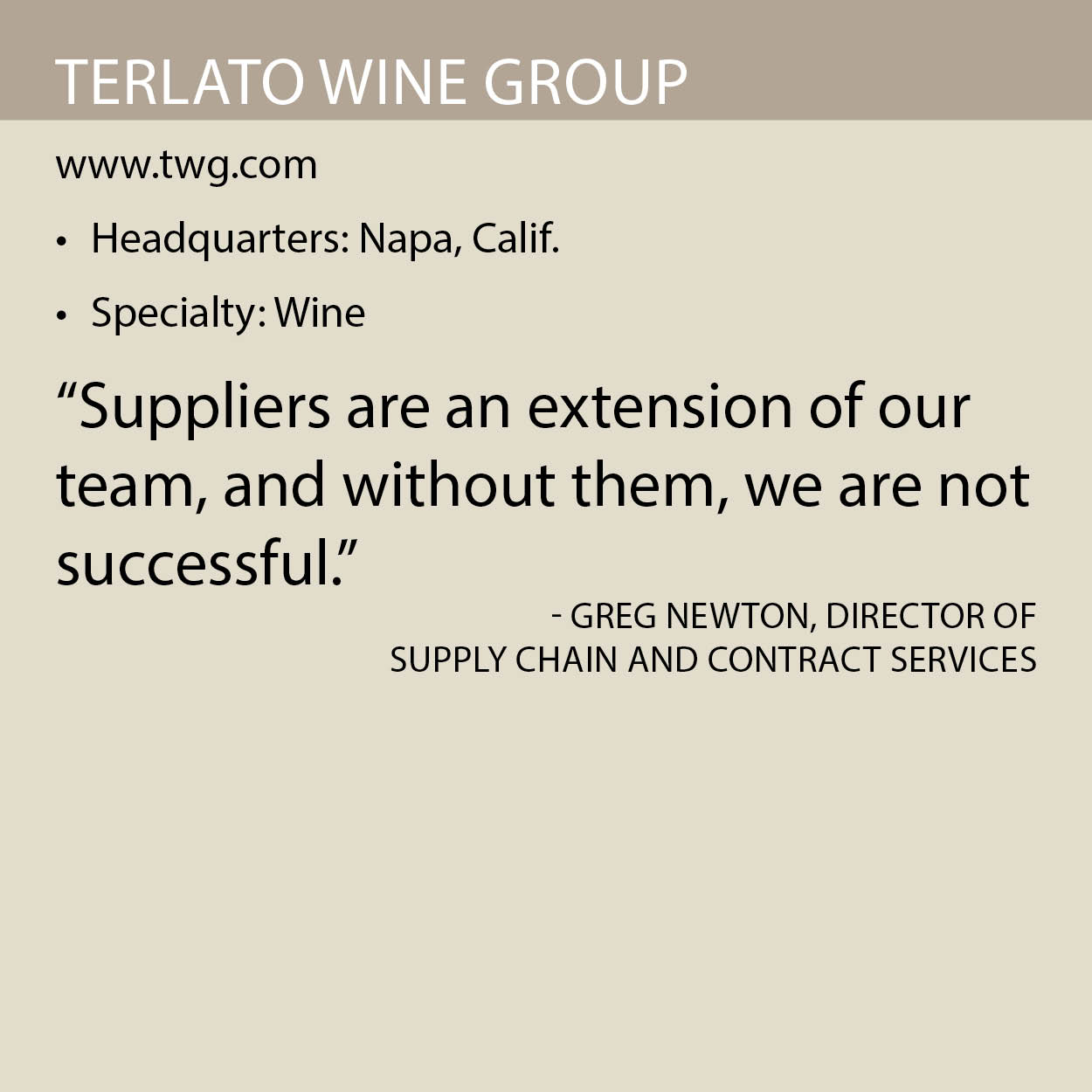Terlato Wine Group – Family Owned Winery Division
Terlato Wine Group’s supply chain ensures that the grapes, glass and other materials it sources are up to its high standards.
By Jim Harris
The Terlato Wine Group (TWG)’s supply chain operations play an important role in ensuring the company fulfills its mission to “put quality first, as quality endures.” For TWG, this means sourcing and producing the finest grapes for its super premium/luxury wine brands and partnering with best-in-class suppliers.
TWG owns and operates three California wineries. “The unique thing about the wine business is that if you have to plant a new vineyard, it can take four or more years before you achieve quality grapes for supply,” says Greg Newton, director of supply chain and contract services for the Napa, Calif.-based company’s family owned wineries division. “When you own your own vineyards, the crop or harvest is variable, which affects your ability to predict and supply the market so you have to be an exceptional communicator.”

TWG’s family owned wineries division includes the Rutherford Hill and Chimney Rock vineyards and wineries, both located in Napa Valley; and Sanford vineyards and winery, located in Santa Barbara, Calif. Each winery produces an eponymous brand. The company also owns other brands including EPISODE, GALAXY, The Federalist and Seven Daughters. The division produces 400,000 cases of wine a year.
The division is one of four business units within TWG. The company also includes Terlato Wines International, a Chicago-headquartered sales and marketing firm with a global portfolio of more than 70 brands from more than 12 countries; a worldwide joint ventures division; and Terlato Artisan Spirits, which includes hand-crafted premium spirits from around the globe.
The company also partners with suppliers of packaging materials such as corks, labels and bottles. TWG bottles various sizes of its wines in all three of its wineries. Rutherford Hill winery houses a permanent bottling line which runs approximately 90 bottles per minute, while the other wineries utilize mobile bottlers to support packaging the final product. The company also retains the services of third-party bottlers.
After wines are bottled, they are shipped to a third-party logistics (3PL) provider, which stores the finished good cases in refrigerated warehouses. Distributors then pick up truckloads of TWG and other wines for future delivery.
A Centralized Approach
Newton joined TWG four years ago as the company’s first dedicated supply chain professional. He is responsible for managing the family owned winery’s procurement, planning, and inventory management,
One of Newton’s first goals after arriving at the company was to implement JD Edwards’ EnterpriseOne enterprise resource planning (ERP) system across the family owned wineries division. “Our Chicago office was using JD Edwards’ ERP to support the financial and distribution side of the business, but it wasn’t in place out here in California,” he says. “Here, they were using Excel spreadsheets for just about everything related to manufacturing.”
The division started using ERP within less than a year of Newton’s tenure. “The benefits we see from ERP include the ability to track inbound raw materials more accurately and efficiently,” Newton says. “We also enhanced the way we work with our accounts payable department to make sure suppliers are paid on time, and can track that.”
Newton also started a centralized procurement department serving all three wineries. “Historically, the winemakers at each of our wineries were responsible for making wine, managing operations, ordering package goods and working with marketing to make sure they bought the right package,” he says. “Transitioning procurement of bottling supplies, much of the marketing integration, and working together on other supply and demand initiatives has allowed the winemakers to focus more on the wine itself, where their passion truly lives.”
TWG’s supply chain team meets frequently with marketing and other departments to manage against forecasted demand and incoming supply needs. Many of the materials used by the company, such as glass, require long lead times. TWG purchases the majority of its glass direct from manufacturers. “Most manufacturers won’t run your glass mold unless you can provide them a 20,000 case commitment on that item, and wineries generally can’t go direct to the manufacturer if they produce less than 1 million cases a year,” Newton says. “We are able to do that because of the way we partner with our suppliers and manage our business overall. We understand our suppliers’ requirements and can work well with them.”
Newton considers managing supplier relationships to be the most important aspect of his job. “A former mentor taught me to use the term supplier instead of vendor. Suppliers are an extension of our team, and without them, we are not successful,” he says.